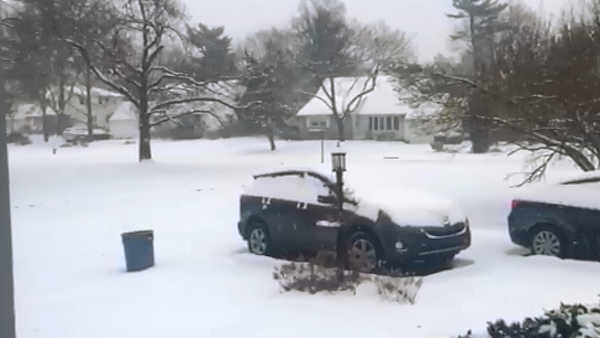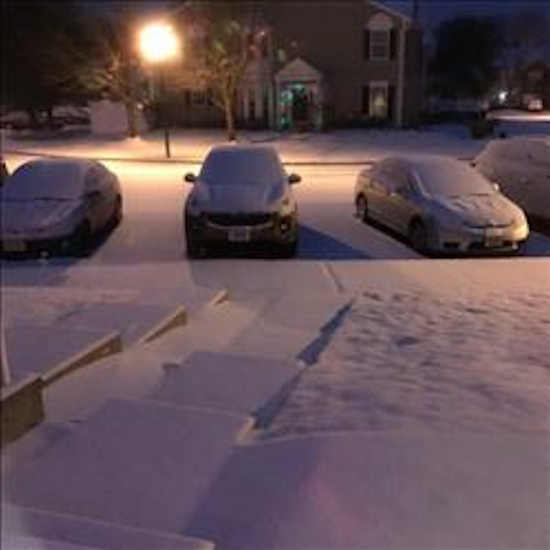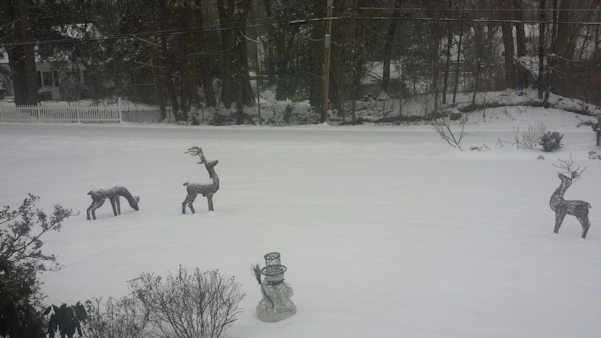Snow, slush make for a messy Saturday

NEW YORK (WABC) -- The first measurable snowfall of the season swept into the New York area Saturday morning, and as the snow came down, crews were busy treating and clearing the roads.
The New York City Emergency Management Department issued a hazardous travel advisory for Saturday.
New Yorkers were advised to exercise caution when driving, walking or biking, and to allow for additional travel time as roads may be slippery.
A total of 1 to 3 inches of snow fell in New York City, with higher amounts north and west.
Temperatures were in the 20s in the early morning when the snowfall started. About half an inch accumulated before sunrise.
By 8 a.m., vehicles were forced to move at a snail's pace in Manhattan - or else spin out of control.
There were some reports of minor accidents.
Up to 4 inches came down in Long Island.
This was the scene Saturday morning in Roslyn Heights, Long Island:
Manalapan, New Jersey:
Chappaqua, New York:
All three of the New York area airports were reporting weather related delays Saturday morning.
Due to the weather conditions, all lanes of the Bayonne Bridge were closed in both directions in Staten Island.
In New Jersey, snow began falling across the state early Saturday, then started changing over to freezing rain by late morning.
Major roads including the Garden State Parkway and the New Jersey Turnpike were in good shape. But drivers were being urged to slow down and use extra caution, especially on secondary and rural roads.
Rain is expected to continue through Saturday afternoon as temperatures remain above freezing.
Safety tips:
Exercise caution and avoid slippery surfaces; some ice may not be visible. Wear sturdy boots that provide traction to reduce slipping. Use handrails when using stairs. Seniors should take extra care outdoors to avoid slips and falls from icy conditions.
When driving in snowy or icy conditions:
--Drive slowly. Vehicles take longer to stop on snow and ice than on dry pavement.
--Use major streets or highways for travel where possible.
--Install good winter tires that have adequate tread. All-weather radials are usually adequate for most winter conditions.
--Four-wheel drive vehicles may make it easier to drive on snow-covered roads, but they do not stop quicker than other vehicles.
--Know your vehicle's braking system. Vehicles with anti-lock brakes require a different braking technique than vehicles without anti-lock brakes in icy or snowy conditions.
--If you are driving and begin to skid, ease your foot off the gas and steer in the direction you want the front of the car to go. Straighten the wheel when the car moves in the desired direction. If you have an anti-lock braking system (ABS), apply steady pressure to the brake pedal. Never pump the brakes on an ABS equipped vehicle.
--Try to keep your vehicle's gas tank as full as possible.
--Keep the name and phone number of at least one local towing service in your car in case you break down or become stuck.
--If you get stuck on the road, stay with your car and contact a towing company.
Tips to prepare:
Make a Plan
--Make sure your Household Disaster Plan is ready and all members of your household are familiar with how to contact one another in an emergency.
--Winterize your Go Bag by adding a blanket, warm socks and gloves.
--Your Emergency Supply Kit should be fully stocked to allow you to sustain yourself for up to three days without power, or in the event you are unable to travel far from home. You may wish to include additional items such as extra blankets, additional warm clothing, and a battery-operated NOAA Weather Radio to monitor weather conditions during a storm.
Winterize Your Home
--Install storm shutters, doors and windows; clean out gutters, repair any roof leaks, and have a contractor check the stability of your roof in the event of a large accumulation of snow.
--Insulate walls and attic. Caulk and weather-strip doors and windows. Install storm windows, or cover windows with plastic from the inside.
--Have safe emergency heating equipment available. For residences with functioning fireplaces, keep an ample supply of wood.
--Install and check batteries in smoke and carbon monoxide detectors.
--Make sure you have sufficient heating fuel; you may have difficulty obtaining fuel in the immediate aftermath of a bad storm.
--Service snow removal equipment, and have rock salt on hand to melt ice on walkways. Kitty litter can be used to generate temporary traction.
Winterize Your Car
Make sure to have a mechanic check the following items on your vehicle:
--Battery
--Antifreeze
--Windshield wipers and washer fluid
--Ignition system
--Thermostat
--Lights (headlamps and hazard lights)
--Exhaust system, heater, brakes, defroster
--Oil level (if necessary, replace oil with a winter oil or SAE 10w/30 variety)
Assemble an Emergency Supply Kit for your vehicle, and consider adding the following items for winter conditions:
--Blankets, sleeping bags, extra newspapers for insulation.
--Extra mittens, socks, scarves and hat, raingear and extra clothes.
--Sack of sand or kitty litter for gaining traction under wheels, small shovel.
--Set of tire chains or traction mats.
--Working jack and lug wrench, spare tire.
--Windshield scraper, broom.
--Small tools (pliers, wrench, screwdriver).
--Booster cables.
--Brightly colored cloth to use as a flag, flares or reflective triangles.
Safety Tips
New Yorkers are also encouraged to take the following precautions during extreme cold:
--Stay indoors as much as possible.
--If you have to go outdoors, wear dry, warm clothing and cover exposed skin. Keep fingertips, earlobes, and noses covered.
--Wear a hat, hood, or scarf, as most heat is lost through the head.
--Shivering is an important first sign that the body is losing heat. Shivering is a signal to return indoors.
--Drinking alcohol may make you think you feel warmer, but it actually increases your chances of hypothermia and frostbite.
--Follow your doctor's advice about performing hard work in the cold if you have heart disease or high blood pressure. Cold weather puts an extra strain on the heart. Remember, your body is already working hard just to stay warm, so don't overdo it.

For more winter weather safety tips, view NYC Emergency Management's video or visit NYC.gov/EmergencyManagement. New Yorkers are also encouraged to sign up for Notify NYC, the city's free emergency notification system. Through Notify NYC, New Yorkers can receive phone calls, text messages, and/or emails alerts about winter weather conditions and other emergencies. To sign up for Notify NYC, call 311, visit NYC.gov/notifynyc, or follow @NotifyNYC on Twitter.







